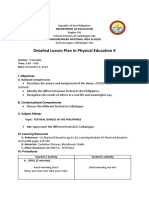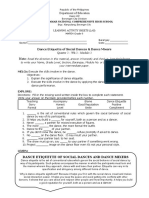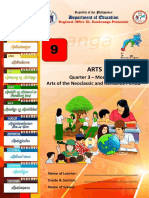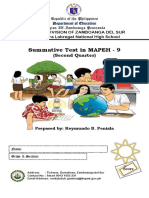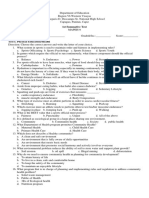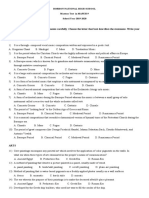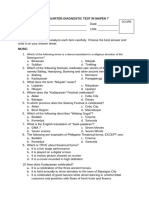100%(2)100% found this document useful (2 votes)
1K viewsMapeh 9 Summative Test
Mapeh 9 Summative Test
Uploaded by
Aira A. Baylan1. The document contains a 30-item summative test on festivals, cultural dances, fitness and wellness, first aid, and related topics.
2. The test consists of multiple choice questions to assess knowledge on different Philippine festivals, examples of locomotor and non-locomotor movements, first aid terms and procedures, and calculating target heart rate.
3. The questions cover topics such as popular festivals in different regions, religious figures honored in festivals, examples of puncture wounds and lacerations, immediate first aid measures like controlling bleeding, and distinguishing signs from symptoms.
Copyright:
© All Rights Reserved
Available Formats
Download as DOCX, PDF, TXT or read online from Scribd
Mapeh 9 Summative Test
Mapeh 9 Summative Test
Uploaded by
Aira A. Baylan100%(2)100% found this document useful (2 votes)
1K views2 pages1. The document contains a 30-item summative test on festivals, cultural dances, fitness and wellness, first aid, and related topics.
2. The test consists of multiple choice questions to assess knowledge on different Philippine festivals, examples of locomotor and non-locomotor movements, first aid terms and procedures, and calculating target heart rate.
3. The questions cover topics such as popular festivals in different regions, religious figures honored in festivals, examples of puncture wounds and lacerations, immediate first aid measures like controlling bleeding, and distinguishing signs from symptoms.
Original Description:
Mapeh 9 Summative Test
Copyright
© © All Rights Reserved
Available Formats
DOCX, PDF, TXT or read online from Scribd
Share this document
Did you find this document useful?
Is this content inappropriate?
1. The document contains a 30-item summative test on festivals, cultural dances, fitness and wellness, first aid, and related topics.
2. The test consists of multiple choice questions to assess knowledge on different Philippine festivals, examples of locomotor and non-locomotor movements, first aid terms and procedures, and calculating target heart rate.
3. The questions cover topics such as popular festivals in different regions, religious figures honored in festivals, examples of puncture wounds and lacerations, immediate first aid measures like controlling bleeding, and distinguishing signs from symptoms.
Copyright:
© All Rights Reserved
Available Formats
Download as DOCX, PDF, TXT or read online from Scribd
Download as docx, pdf, or txt
100%(2)100% found this document useful (2 votes)
1K views2 pagesMapeh 9 Summative Test
Mapeh 9 Summative Test
Uploaded by
Aira A. Baylan1. The document contains a 30-item summative test on festivals, cultural dances, fitness and wellness, first aid, and related topics.
2. The test consists of multiple choice questions to assess knowledge on different Philippine festivals, examples of locomotor and non-locomotor movements, first aid terms and procedures, and calculating target heart rate.
3. The questions cover topics such as popular festivals in different regions, religious figures honored in festivals, examples of puncture wounds and lacerations, immediate first aid measures like controlling bleeding, and distinguishing signs from symptoms.
Copyright:
© All Rights Reserved
Available Formats
Download as DOCX, PDF, TXT or read online from Scribd
Download as docx, pdf, or txt
You are on page 1of 2
Mapeh 9 Summative Test.
Choose the letter of the correct answer.
1. The following festivals are celebrated in honor of Sto. Niño except one.
a. Ati-Atihan b. Bangus Festival c. Dinagyang Festival d. Sinulog Festival
2. Which of the following is a cultural dance performed to the strong beats of percussion instruments by a community of people
sharing the same culture usually done in honor of a Patron Saint or in thanksgiving of a bountiful harvest?
a. Cultural dance b. Festival dance c. Folk dance Social dance
3. How can festival dancing contribute to one’s fitness and well-being?
a. It reduces the risk of cardio-respiratory diseases b. It facilitates teamwork and sense of community.
c. It maximizes our use to energy and enhances cardio-respiratory health d. It is good form of exercise.
4. How can one benefit from festival dancing activities?
a. They help one achieve a personality active lifestyle.
b. They contribute to the enhancement of community awareness.
c. They develop one’s awareness of his own and other’s culture through festivals.
d. All of the above
5. These are movements that allow you to move from one point in space to another.
a. Locomotor movements b. Religious festivals c. Non-locomotor movements d. Warm-up exercise
6. Which of the following is an example of a religious festival?
a. Panagbenga festival b. Peñafrancia c. T’ nalak festival d. Ammungan festival
7. The pace of origin of Ati-Atihan Festival?
a. Dagupan City b. Cebu City c. Kalibo, Aklan d. Tacloban City
8. Which of the following is an example of non-religious festivals ?
a. Higante festival b. Sinulog festival c. Kinabayo festival d. Mango festival
9. What is the name of Festival in Iloilo City usually celebrated in January?
a. Binatbatan b. Pattarradday c. Dinagyang d. Bambanti
10. This movement is simply described by having both feet lose its contact with the ground.
a. Walk b. Jump c. Run d. Step
11. It is the act of decreasing the angle of a joint.
a. Flexion b. Extension c. Release d. Trust
12. The basis of all locomotor movements.
a. Walk b. Jump c. Run d. Step
13. The following are popular festivals in Pangasinan except one.
a. Bangus festival b. Mango festival c. Bagoong festival d. Pindang festival
14. What religious figure honored in Sangyaw Festival.
a. Sto. Nino b. James the Great c. Saint Paul d. Virgin Mary
15. Refers to deliberately drop or exertion to energy into a body segment.
a. Collapse b. Twist c. Extention d. Recover
16. What is the lowest target heart rate (60%) of a student with a PMHR of 200?
a. 203 b. 208 c. 200 d. 210
17. The opposite of collapse.
a. Release b. Contraction c. Endurance d. Recover
18. Which of the following is a word for extension?
a. Enhancing b. Stretching c. Contraction d. Flexion
19. What principle advocates safety awareness which is essential in achieving quality of life?
a. “Prevention is better than cure” c. “Protection is better than cure”
b. “Safety is better than cure” d. “Care is better than cure”
20. What do you call an immediate and temporary care given to a person who suddenly gets ill or injured?
a. Medicine Kit b. First Aid c. Prevention d. Cure
21. What is the difference between signs and symptoms?
a. Signs are sensations that the victim feels or experiences and maybe able to describe while symptoms are details discovered by
applying your senses.
b. Signs include nausea while symptoms include bleeding.
c. Signs are details discovered by applying your senses while symptoms are sensations that the victim feels or experiences and
maybe able to describe.
d. Sign include impaired sensations while symptoms include deformities.
22. If men’s normal pulse rate is 60-70, how about women?
a. 70-80 b. 80-90 c. 80-120 d. 110-130
6. What do you call a piece of sterile cloth that covers a wound to prevent infection/or to stop bleeding?
a. Cold Compress b. Hot Compress c. Dressing d. Adhesive Tape
23. When can you say that a wound is a puncture?
a. When the wound is caused by any sharp object c. When a wound is caused by mishandling tools
c. When a wound is caused by nails d. When a wound is caused by a broken glass
24. Which of the following is caused by laceration?
a. Pointed objects c. Tearing of soft tissue resulting to mishandling tools
b. Sharp objects d. Scrapping the skin against rough surface
25. What do you call the easiest way to transport a light and smaller victim?
A. Piggy Back B. Fireman’s Carry C. Pack Strap Carry D. Blanket Drag
26. Which of the following is caused by consuming food or drink that is contaminated with bacteria or viruses?
A. Choking B. Drowning C. Food poisoning D. Chemical burns
27. What do you call an act of investigating or examining something?
a. Research b. Survey c. Experiment d. Discover
28. A medical doctor is also called________.
a. Teacher a. Physician c. Engineer d. Veterinarian
29. What do you call a person giving first aid?
a. First Aide b. First Aider c. Laboratory Aide d. Medical Aide
30. Which of the following is the first step in managing hematoma?
a. Ice Application b. Compression c. Resting the injured part d. Elevation
You might also like
- Physical Education 9 TestDocument10 pagesPhysical Education 9 TestBrian-Evelyn Eclipse100% (1)
- Summative Test in Mapeh 9-3rdquarterDocument4 pagesSummative Test in Mapeh 9-3rdquarterK-annie Marie Marata Sayon100% (5)
- TQ MAPEH 9 - 2ND QuarterDocument5 pagesTQ MAPEH 9 - 2ND QuarterAira A. Baylan95% (20)
- Summative Test 3rd HealthDocument2 pagesSummative Test 3rd HealthTolentino Calacala Gloria75% (4)
- Second Diagnostic Test in Mapeh 9Document2 pagesSecond Diagnostic Test in Mapeh 9Mina Berdos Sabit100% (3)
- Summative Test in Mapeh 9 (Third Quarter)Document4 pagesSummative Test in Mapeh 9 (Third Quarter)ALBERT TERANA82% (11)
- 3rd Quarter Summative Test in PDocument2 pages3rd Quarter Summative Test in PEdward Llanera Orpilla100% (1)
- PE 3rd PERIODIC TESTDocument3 pagesPE 3rd PERIODIC TESTrachel100% (1)
- 4th Quarter Exam Grade 9Document2 pages4th Quarter Exam Grade 9Noemi Balbido100% (2)
- SUMMATIVE TEST Quarter 4 Mapeh 9Document3 pagesSUMMATIVE TEST Quarter 4 Mapeh 9Mary Cris100% (1)
- FESTIVAL IN THE PHILIPPINES (PE9RD-IIb-1)Document9 pagesFESTIVAL IN THE PHILIPPINES (PE9RD-IIb-1)Judy Ann MorilloNo ratings yet
- Summative TEST MAPEH 9 Q3Document15 pagesSummative TEST MAPEH 9 Q3elizabeth ocumen100% (3)
- THIRD PERIODICAL TEST IN MAPEH 9.editedDocument4 pagesTHIRD PERIODICAL TEST IN MAPEH 9.editedRhea Meszurika TambobongNo ratings yet
- First Summative Test in Arts 9 First QuarterDocument5 pagesFirst Summative Test in Arts 9 First QuarterRHEEZA AOALINNo ratings yet
- 3rd Quarter Exam MAPEH 9Document3 pages3rd Quarter Exam MAPEH 9mae santos50% (2)
- Quiz Arts 9 3RD QuarterDocument2 pagesQuiz Arts 9 3RD QuarterRosel Librado100% (1)
- Summative Test in Physical Education G-9 Test L. Multiple Choice: Select The Nearest Answer. Write Only The Letter of YourDocument4 pagesSummative Test in Physical Education G-9 Test L. Multiple Choice: Select The Nearest Answer. Write Only The Letter of YourArthur Capawing100% (1)
- 2nd Periodical Exam MAPEH 9Document5 pages2nd Periodical Exam MAPEH 9Brix MallariNo ratings yet
- 3rd Quarter Mapeh 9Document1 page3rd Quarter Mapeh 9Jessemar Solante Jaron WaoNo ratings yet
- 4TH Quarter - 9 MusicDocument12 pages4TH Quarter - 9 MusicLynn Roa Dagsa - Miniao100% (1)
- Test I-Multiple Choice. Read Each Statement Carefully and Choose The Letter That Best Corresponds To TheDocument3 pagesTest I-Multiple Choice. Read Each Statement Carefully and Choose The Letter That Best Corresponds To TheMarie Sha Alojado0% (1)
- Summative Test 3rdDocument3 pagesSummative Test 3rdDhennis Kurt Lagoy100% (1)
- Summative Test Quarter 4 Week 2 Health 9Document2 pagesSummative Test Quarter 4 Week 2 Health 9Mary Cris100% (2)
- LAS (PE 9) - MELC 2 - Quarter 2Document3 pagesLAS (PE 9) - MELC 2 - Quarter 2Melody Joy AmoscoNo ratings yet
- Pretest Posttest Mapeh 9.Document2 pagesPretest Posttest Mapeh 9.Konoha Maru100% (3)
- SUMMATIVE TEST (Arts 2nd Quarter) - 2019Document1 pageSUMMATIVE TEST (Arts 2nd Quarter) - 2019Melody Joy AmoscoNo ratings yet
- Tipas National High School: Prelim in MAPEH GRADE 9Document3 pagesTipas National High School: Prelim in MAPEH GRADE 9Myra Paitan IliganNo ratings yet
- Fourth Quarter Examination in Mapeh IxDocument1 pageFourth Quarter Examination in Mapeh IxFatima Lagapa100% (4)
- 2nd Periodical Exam 2019 2020Document3 pages2nd Periodical Exam 2019 2020Cherilyn DequitNo ratings yet
- 4th-QUARTER-long Quiz PE 9Document2 pages4th-QUARTER-long Quiz PE 9ronaNo ratings yet
- Grade 9 ARTS Q3 - M2Document16 pagesGrade 9 ARTS Q3 - M2Marjun Oliveros MacadangdangNo ratings yet
- Music & Arts: Learner's Activity SheetDocument4 pagesMusic & Arts: Learner's Activity SheetChrisryne Joy DadoNo ratings yet
- 3rd Quarter Quiz in MusicDocument1 page3rd Quarter Quiz in MusicRodRigo Mantua Jr.No ratings yet
- Grade 9 P.E. Q4 Module 1 2 WK1 2raDocument16 pagesGrade 9 P.E. Q4 Module 1 2 WK1 2raRealyn Mabansag100% (2)
- Mapeh 9 P.E. Q4Document34 pagesMapeh 9 P.E. Q4Charmaine JanorasNo ratings yet
- Summative Test ArtDocument3 pagesSummative Test ArtKen PeraltaNo ratings yet
- Summative Test Grade 9 (Music) : Department of EducationDocument2 pagesSummative Test Grade 9 (Music) : Department of EducationJunard CenizaNo ratings yet
- Health: Quarter 3 - Module 5: Techniques in Carrying and Transporting The VictimDocument19 pagesHealth: Quarter 3 - Module 5: Techniques in Carrying and Transporting The VictimNnayz0% (1)
- San Jose Pili National High School Pre-Test in Mapeh 9Document3 pagesSan Jose Pili National High School Pre-Test in Mapeh 9Lorenel InterinoNo ratings yet
- 2ndQ Pandemic Summative Test in MAPEH-9Document4 pages2ndQ Pandemic Summative Test in MAPEH-9Reymundo PenialaNo ratings yet
- 3rd PERIODIC EXAM IN MAPEH 9Document4 pages3rd PERIODIC EXAM IN MAPEH 9rhenz deztroid100% (5)
- Answer Key Q3 Exam Mapeh 9Document4 pagesAnswer Key Q3 Exam Mapeh 9Jessieann Balmaceda Cabangan100% (3)
- 1st SUmmative Test in Mapeh 9Document2 pages1st SUmmative Test in Mapeh 9Cristena Delos Santos Deondo89% (9)
- MAPEH 9 PE and Halth 2nd Quarter Examination FinalDocument2 pagesMAPEH 9 PE and Halth 2nd Quarter Examination Finalcecile80% (10)
- 4TH Quarter - 9 HealthDocument6 pages4TH Quarter - 9 HealthLynn Roa Dagsa - Miniao100% (1)
- MAPEH 9 Q1 Achievement TestDocument3 pagesMAPEH 9 Q1 Achievement Testayell obligadoNo ratings yet
- MAPEH 9 1st Mastery TestDocument3 pagesMAPEH 9 1st Mastery TestJonel Rule100% (2)
- Music 9 - Q3 - wk1 & 2 SummativeDocument2 pagesMusic 9 - Q3 - wk1 & 2 SummativeAnn Cuartero Sanchez0% (1)
- Worksheet No.1: Grade 9Document5 pagesWorksheet No.1: Grade 9Lino Anthony Banatao100% (1)
- WEEK 7-8: Health 9 Module 4Document8 pagesWEEK 7-8: Health 9 Module 4Heidee BasasNo ratings yet
- NAME: - SECTION: - Quarter 1 - Summative Test MAPEH G9 2021 - 2022Document2 pagesNAME: - SECTION: - Quarter 1 - Summative Test MAPEH G9 2021 - 2022raquel100% (1)
- Summative Test in Mapeh 9 Quarter 2 Music and ArtDocument2 pagesSummative Test in Mapeh 9 Quarter 2 Music and ArtAnne Eliver Centena0% (2)
- Third Periodical Test in Mapeh 9&10Document9 pagesThird Periodical Test in Mapeh 9&10RhonaVillanuevaLayco100% (1)
- Pe9 q2 Mod1 Socialdances Version2Document17 pagesPe9 q2 Mod1 Socialdances Version2Christel Divine Garcia100% (1)
- 2nd Periodical Test in Mapeh 9 FinalDocument5 pages2nd Periodical Test in Mapeh 9 FinalNube Sempai100% (4)
- PT 3rd Mapeh 9Document2 pagesPT 3rd Mapeh 9Calvin Cabacungan100% (2)
- Summative Test - P.E. HealthDocument1 pageSummative Test - P.E. HealthDeleon AizaNo ratings yet
- Mapeh 9 - Pre AssessmentDocument4 pagesMapeh 9 - Pre AssessmentDW7 EYHNo ratings yet
- Nine ExamDocument6 pagesNine ExamRoderick Beltran Lutang100% (1)
- Q4 ASSESSMENT - MAPEH 7 - Test QuestionnaireDocument4 pagesQ4 ASSESSMENT - MAPEH 7 - Test QuestionnaireDavid Joshua RosalesNo ratings yet
- Grade 12 Assessment Tool First QuarterDocument7 pagesGrade 12 Assessment Tool First QuarterRowena FloresNo ratings yet
- Diagnostic Test Mapeh 9Document4 pagesDiagnostic Test Mapeh 9Aira A. Baylan100% (2)
- Quiz in PE 9Document1 pageQuiz in PE 9Aira A. Baylan0% (1)
- Department of Education Region VII, Central Visayas Division of City Schools Division of Naga Antonio R. Lapiz National High SchoolDocument1 pageDepartment of Education Region VII, Central Visayas Division of City Schools Division of Naga Antonio R. Lapiz National High SchoolAira A. BaylanNo ratings yet
- 2nd Quiz ScienceDocument1 page2nd Quiz ScienceAira A. BaylanNo ratings yet
- Sample Test QuestionsDocument1 pageSample Test QuestionsAira A. BaylanNo ratings yet
- Role PlayDocument2 pagesRole PlayAira A. BaylanNo ratings yet
- Republic of The Philippines Cebu Technological University Graduate School Cebu City Campus Corner M.J. Cuenco Ave. & R. Palma ST., Cebu CityDocument2 pagesRepublic of The Philippines Cebu Technological University Graduate School Cebu City Campus Corner M.J. Cuenco Ave. & R. Palma ST., Cebu CityAira A. BaylanNo ratings yet
- Long Quiz in Science 8Document1 pageLong Quiz in Science 8Aira A. BaylanNo ratings yet
- A Narrative Report About Arts MonthDocument3 pagesA Narrative Report About Arts MonthAira A. BaylanNo ratings yet
- 1ST Quarter NSED 2021 MOVDocument1 page1ST Quarter NSED 2021 MOVAira A. BaylanNo ratings yet
- Financial Literacy: Anne A. Alban Family Welfare OfficerDocument66 pagesFinancial Literacy: Anne A. Alban Family Welfare OfficerAira A. BaylanNo ratings yet
- Pre Test Earth and Life ScienceDocument2 pagesPre Test Earth and Life ScienceAira A. BaylanNo ratings yet
- Department of Education Region VII, Central VisayasDocument7 pagesDepartment of Education Region VII, Central VisayasAira A. Baylan100% (2)










